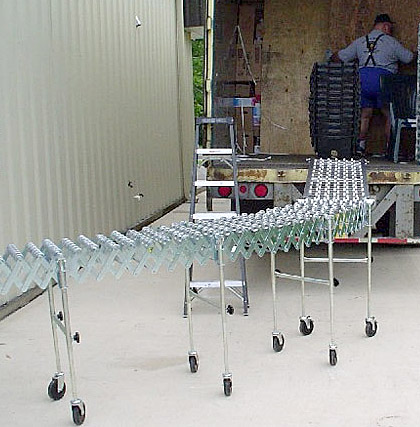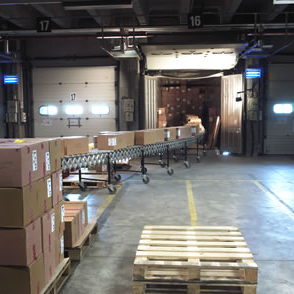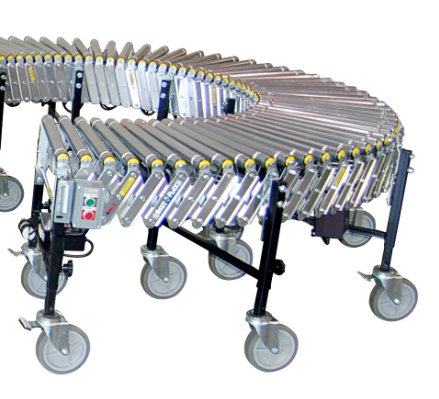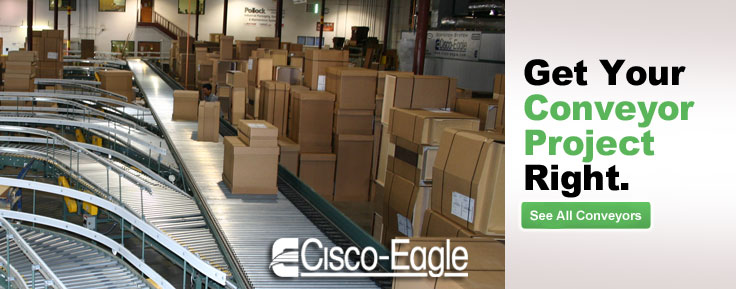The Ergonomics of Flexible Conveyors
How to ensure your conveyor is used safely and productively

As we have covered previously, conveyors contribute to ergonomics in material handling operations by reducing repetitive lifts, twists, reaching and materials movement that may have been done by hand without them. Eliminating manual lifting and carrying reduces the chances for painful, expensive musculoskeletal injuries. It’s not about the once-in-a-while lift/carry. It’s about the same, repetitive motions over and over.
It’s important that your conveyor is configured correctly to make this work.
Flexible conveyor “fills the gaps”
One of the most overlooked areas is the space between a truck and a dock; a conveyor belt and a trailer; a loaded pallet and a processing line. These are the places where flexible conveyors fill the gap by eliminating manual handling. Flexible conveyors let you convey items in areas where fixed systems aren’t possible. This ability to fit the needed situation (even if the situation changes) is critical for many companies who must bridge a gap and don’t want to do that with manual handling.
How to use flexible conveyors safer and more efficiently
It’s critical that everyone in the area know how to use the conveyor – and that they must use the conveyor.
Make sure the conveyor is being utilized
If you install conveyors in these “gaps” in your material handling areas, the assumption may be that people will use them, and that’s not always true. People may resist the change. Why?
- People always resist changes, even changes designed for their benefit
- People resist things that inconvenience them. The conveyor may not be as convenient as tossing boxes from the end of a line to an open door, and some people will ignore it, even if it’s faster than the old way. Ergonomic additions that slow down the process (or appear to at first, even if not in reality) are sometimes resisted.
- Young, strong workers often see little benefit in ergonomic processes, and don’t see why it is harmful to lift and carry something. Even if they are doing that hundreds of times a year, and that effort could eventually injure them.
- Workers may not see the benefit of the conveyor. It’s up to you to enforce its use as part of the process.

Train to use the conveyor correctly
Workers should receive training on how to use the conveyors. How to move them, set wheel brakes, how to flex them for maximum effectiveness. This should include safety training for the entire area. Good training protects people, the conveyor and the load. When you extend the conveyor (or collapse it), make sure people use the handles designed for that, and that they aren’t grabbing other parts. Those handles are also there for rolling the conveyor around. Everyone should know how to lock or unlock the casters.
Make sure people understand the load: Conveyors all have specified capacities. If that’s exceeded, jams or equipment damage are possible. Be sure your conveyor is built for the heaviest pieces it’s expected to transport.
Adhere to basic safety rules
Flexible conveyors are very safe equipment, and a few basic rules help keep them that way.
- Don’t allow clothes or hair to dangle near the conveyor. This goes for all types, not just flexible. Your operators should tie back hair, take off jewelry, and wear clothes that aren’t loose-fitting or baggy.
- Lock the conveyor down. All flexible conveyors come with lockable casters. When it’s positioned for use, lock it down.
- Keep fingers and hands clear. Don’t stick them between rollers, skatewheels or the side links that create the “scissor” action on the sides.
- Don’t transition from dock to trailer without a dock plate. Its wheels should never bump into an open gap. Pull the conveyor onto the plate from the front – not the sides.
Maintenance makes all the difference

Like all mechanical equipment, conveyors require maintenance. With proper maintenance the conveyor will last longer and perform better. It won’t be as likely to go down the day you’re slammed. It will also be safer for your employees if it’s well-maintained.
What are the basic maintenance steps?
- Replace worn-out or broken parts. This is minimal effort and cost but can really pay off in productivity.
- Keep the conveyor clean. Don’t let debris and dust accumulate on it. In warehouse or plant conditions, dust and accumulated debris is the enemy of all mechanical equipment. Regular cleaning also reduces parts damage and replacement costs.
- Be double sure that safety mechanisms are in place and working.
These simple maintenance steps are only general in scope Conveyors come with manuals with the exact information for your specific system.
Final thoughts
Since flexible conveyors “fill the gap” where conventional systems cannot, they are often put in awkward, difficult areas. They move around. Paying attention to these safety and ergonomic aspects will pay off over the years as your facility becomes that much safer and efficient. Let us know if you need any assistance with your conveyor project. We’re happy to answer all questions.

More resources
- Flexible conveyors: prices, specs
- Flexible conveyor videos
- The dock is your first line of customer service
Tags: ergonomics, worker safety, loading docks
Scott Stone is Cisco-Eagle's Vice President of Marketing with 35 years of experience in material handling, warehousing and industrial operations. His work is published in multiple industry journals an websites on a variety of warehousing topics. He writes about automation, warehousing, safety, manufacturing and other areas of concern for industrial operations and those who operate them.



